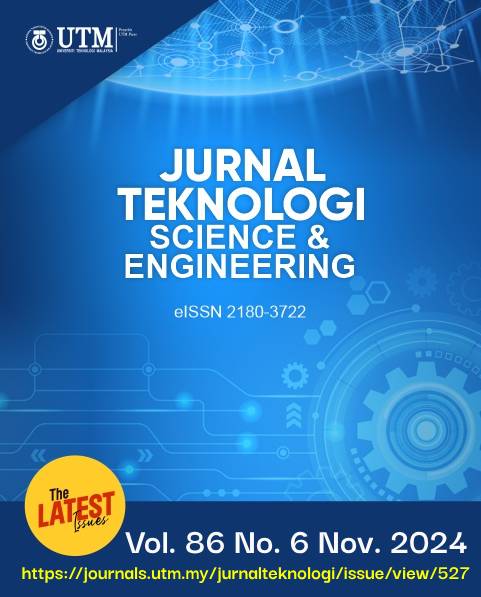EXPERIMENTAL STUDY ON COMPRESSIVE STRENGTH AND SHEAR STRENGTH OF MASONRY UNIT WITH FIBER GLASS AND POLYPROPYLENE FIBER PAINT COATING
DOI:
https://doi.org/10.11113/jurnalteknologi.v86.21658Keywords:
Fiber Paint, Polypropylene, Fiberglass, Compressive Strength, Shear StrengthAbstract
In this study, the effects of fiber layers on the compressive and shear strength properties of masonry are investigated. The aim is to improve the mechanical properties of masonry walls that are prone to earthquakes The experimental investigations provide information on the mechanical properties of Indonesian masonry blocks under two conditions: without and with fiber coating. Two different types of fibers were used in this study: Fibreglass and Polypropylene fiber. The fiber content is 8% for 1 kg of paint with 5% water. The thickness of the coating applied to the masonry ranges from 1 mm to 3 mm. The compressive strength of the samples with a layer of polypropylene fibers with a thickness of 1 mm and 3 mm is 30.32 kg/cm², 31.16 kg/cm² and 47.16 kg/cm², respectively. The compressive strength of the samples with a layer of glass fiber paint with a thickness of 1 mm, 2 mm, and 3 mm is 30.1 kg/cm², 31.22 kg/cm², 53.31 kg/cm² and the value of the control sample is 25.89 kg/cm². The shear strength of masonry with polypropylene-coated fiber with a layer thickness of 1 mm, 2 mm, and 3 mm is 3.93 kg/cm², 4.64 kg/cm², and 5.89 kg/cm². The bricks reinforced with glass fiber paint with a layer thickness of 1 mm, 2 mm, and 3 mm have 3.77 kg/cm², 5.31 kg/cm², and 5.05 kg/cm².
References
T. D. Krevaikas. 2019. Experimental Study on Carbon Fiber Textile Reinforced Mortar System as a Means for Confinement of Masonry Columns. Constr. Build. Mater. 208: 723-733. Doi: 10.1016/j.conbuildmat.2019.03.033.
P. Supendi et al. 2023. A Previously Unidentified Fault Revealed by the February 25, 2022 (Mw 6.1) Pasaman Earthquake, West Sumatra, Indonesia. Phys. Earth Planet. Inter. 334: 106973. Doi: 10.1016/j.pepi.2022.106973.
Rafki Imani, Hengki Kurniawan, and Deded Eka Sahputra. 2022. Identification of Damage Levels of Residents’ Houses Due to Earthquake in Pasaman 2022. Civ. Eng. Collab. 35-41. Doi: 10.35134/jcivil.v7i2.46.
A. M. Julius et al. 2022. An On-Site Post-Event Survey of the 2022 Mw 6.1 Western Pasaman Sumatera Destructive Earthquake. NTU Journal for Renewable Energy. 2(1): 39-49.
E. Gunawan and S. Widiyantoro. 2019. Active Tectonic Deformation in Java, Indonesia Inferred from a GPS-Derived Strain Rate. J. Geodyn. 123: 49-54. Doi: 10.1016/j.jog.2019.01.004.
E. Juliafad. 2022. Seismic Fragility Function for Single Storey Masonry Wall Rc Building in Padang City, Indonesia. Int. J. GEOMATE. 22(94). Doi: 10.21660/2022.94.3160.
E. Juliafad. 2021. Defect Study on Single Storey Reinforced Concrete Building in West Sumatra: Before and After 2009 West Sumatra Earthquake. Int. J. GEOMATE. 20(77). Doi: 10.21660/2020.77.ICEE03.
E. Juliafad, I. G. Rani, F. Rifwan, and Y. F. P. 2019. Concreting Workmanship in Indonesia Study Case: Padang City, West Sumatra, Indonesia. Int. J. Adv. Sci. Eng. Inf. Technol. 9(1): 300. Doi: 10.18517/ijaseit.9.1.7201.
A. Furtado, H. Rodrigues, A. Arêde, and H. Varum. 2020. Experimental Tests on Strengthening Strategies for Masonry Infill Walls: A Literature Review. Constr. Build. Mater. 263: 120520. Doi: 10.1016/j.conbuildmat.2020.120520.
N. Ademović, M. Toholj, D. Radonić, F. Casarin, S. Komesar, and K. Ugarković. 2022. Post-Earthquake Assessment and Strengthening of a Cultural-Heritage Residential Masonry Building after the 2020 Zagreb Earthquake. Buildings. 12(11): 2024. Doi: 10.3390/buildings12112024.
S. Banerjee, S. Nayak, and S. Das. 2019. Enhancing the Flexural Behaviour of Masonry Wallet using PP Band and Steel Wire Mesh. Constr. Build. Mater. 194: 179-191. Doi: 10.1016/j.conbuildmat.2018.11.001.
N. Sathiparan. 2020. State of Art Review on PP-band Retrofitting for Masonry Structures. Innov. Infrastruct. Solut. 5(2): 62. Doi: 10.1007/s41062-020-00316-9.
A. Furtado, H. Rodrigues, H. Varum, and A. Costa. 2017. Evaluation of Different Strengthening Techniques’ Efficiency for a Soft Storey Building. Eur. J. Environ. Civ. Eng. 21(4): 371-388. Doi: 10.1080/19648189.2015.1119064.
A. P. Melinda and E. Juliafad. 2022. Experimental Study of Masonry Wall Strengthened by Polypropylene Fiber Mortar. Int. J. Adv. Sci. Eng. Inf. Technol. 12(3): 1066. Doi: 10.18517/ijaseit.12.3.11198.
R. Junior and E. Juliafad. 2022. Metode Perkuatan Interlocking Pasangan Bata Merah Menggunakan Baja Tulangan Polos Diameter 6mm. Jurnal Applied Science in Civil Engineering. 3(1): 33-37
N. Gattesco and I. Boem. 2017. Characterization Tests of GFRM Coating as a Strengthening Technique for Masonry Buildings. Compos. Struct. 165: 209-222. Doi: 10.1016/j.compstruct.2017.01.043.
G. Liu, W. Cheng, and L. Chen. 2017. Investigating and Optimizing the Mix Proportion of Pumping Wet-mix Shotcrete with Polypropylene Fiber. Constr. Build. Mater. 150: 14-23. Doi: 10.1016/j.conbuildmat.2017.05.169.
Z. Yuan and Y. Jia. 2021. Mechanical Properties and Microstructure of Glass Fiber and Polypropylene Fiber Reinforced Concrete: An Experimental Study. Constr. Build. Mater. 266: 121048. Doi: 10.1016/j.conbuildmat.2020.121048.
G. Sarangapani, B. V. Venkatarama Reddy, and K. S. Jagadish. 2005. Brick-Mortar Bond and Masonry Compressive Strength. J. Mater. Civ. Eng. 17(2): 229-237. Doi: 10.1061/(ASCE)0899-1561(2005)17:2(229).
S. B. Singh and P. Munjal. 2017. Bond Strength and Compressive Stress-strain Characteristics of Brick Masonry. J. Build. Eng. 9: 10-16. Doi: 10.1016/j.jobe.2016.11.006.
A. Al-Fakih, M. M. A. Wahab, B. S. Mohammed, M. S. Liew, N. A. Wan Abdullah Zawawi, and S. As’ad. 2020. Experimental Study on Axial Compressive Behavior of Rubberized Interlocking Masonry Walls. J. Build. Eng. 29: 101107. Doi: 10.1016/j.jobe.2019.101107.
Downloads
Published
Issue
Section
License
Copyright of articles that appear in Jurnal Teknologi belongs exclusively to Penerbit Universiti Teknologi Malaysia (Penerbit UTM Press). This copyright covers the rights to reproduce the article, including reprints, electronic reproductions, or any other reproductions of similar nature.
















